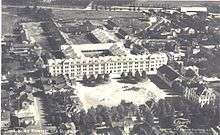Norrland Dragoon Regiment
| Norrland Dragoon Regiment | |
|---|---|
| Norrlands dragonregemente | |
|
Coat of arms | |
| Active | 1853–2004 |
| Country | Sweden |
| Type | cavalry regiment |
| Colors | Blue and orange-yellow |
| Engagements | Nowodwor 1655 |
The Norrland Dragoon Regiment (Swedish: Norrlands dragonregemente), also K 4 or K 8, was a Swedish Army cavalry regiment located in the province of Lappland that traces its origins back to the 17th century. It is still in active service as the Norrland Dragoons detachment of Norrbotten Regiment (I 19), still located in Arvidsjaur. The current name of the fighting unit is Arméns Jägarbataljon (Swedish Army Ranger Battalion).
Units from AJB have been involved in Afghanistan, Bosnia, Kosovo, Pakistan, Ukraine and Chad (continuously in Afghanistan since 2004).[1]
History

The regiment has its origin in the Ångermanland, Medelpad and Jämtland Regiment raised in 1646. From 1689 on, this regiment was named Jämtland Dragoon Regiment, but had only one company of cavalry troops. This company was semi-separate, with the name Jämtland Cavalry Company (Jämtlands kavallerikompani) and had been split off from Bohus-Jämtland Cavalry Squadron in 1670. The company was renamed Jämtlands hästjägarskvadron in 1802 and after receiving another squadron it was organized into a battalion and renamed Jämtlands hästjägarkår in 1834.
The corps gained full status as a separate unit in 1853 and was given the designation K 8 (8th Cavalry Regiment). It was renamed Norrland Dragoon Regiment in 1892 and when merged with parts of the Crown Prince's Hussar Regiment in 1927 it was redesignated K 4 but kept its name before being reorganized to a battalion and renamed Norrland's Dragoons in 1958. Finally the regiment was renamed back to its old name in 1980.
See also the history for Jämtland Rifle Regiment.
Commanders
Below are regimental commanders between 1900 and 2004. The period between 1957 and 1980, the unit consisted of a battalion, and the commander was battalion commander and subordinate the commander of Västerbotten Regiment.[2]
|
|
Campaigns
- None
See also the campaigns for Jämtland Rifle Regiment.
Organization
1833
- Livskvadronen
- Alsens skvadron
See also the organization for Jämtland Rifle Regiment.
Various
The regimental names:
| Bohus-Jämtlands kavalleriskvadron | Bohuslän-Jämtland Cavalry Squadron | 5 September 1661 | – | 1670 |
| Jämtlands kavallerikompani | Jämtland Cavalry Company | 1670 | – | 1802 |
| Jämtlands hästjägarskvadron | Jämtland Horse Ranger Squadron | 1802 | – | 18 July 1834 |
| Jämtlands hästjägarkår | Jämtland Horse Ranger Corps | 19 July 1834 | – | 31 December 1892 |
| Norrlands dragonregemente | Norrland Dragoon Regiment | 1 January 1893 | – | 30 June 1958 |
| Norrlands dragoner | Norrland's Dragoons | 1 July 1958 | – | 31 March 1980 |
| Norrlands dragonregemente | Norrland Dragoon Regiment | 1 April 1980< | – |
| K 8 | 25 May 1853 | – | 31 December 1927 |
| K 4 | 1 January 1928 | – |
| Frösö läger | 1802 | – | 1894 |
| Stockholm (G) | 1894 | – | 12 October 1900 |
| Umeå (G) | 13 October 1900 | – | 31 March 1980 |
| Arvidsjaur (G) | 1 April 1980 | – |
See also
References
- See the Swedish regiments article for general references.
- ↑ http://www.forsvarsmakten.se/i19/Om-forbandet/Armens-jagarbataljon/
- ↑ Braunstein, Christian (2003). Sveriges arméförband under 1900-talet. Skrift / Statens försvarshistoriska museer, 1101-7023 ; 5 (in Swedish). Stockholm: Statens försvarshistoriska museer. p. 146. ISBN 91-971584-4-5.
Coordinates: 65°34′50″N 19°09′53″E / 65.58056°N 19.16472°E
